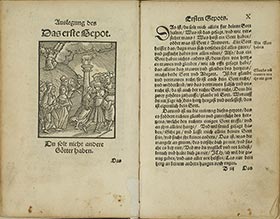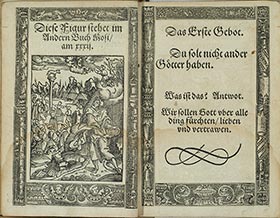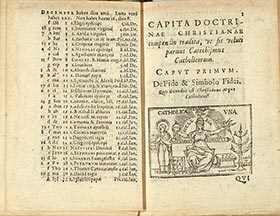
Teaching Christian Eyes
- Lee Palmer Wandel
_______________________________

Fig. 1. M. Luther, Deudsch Catechismus, 1531 

Fig. 2. M. Luther, Enchirion, 1531 

Fig. 3. P. Canisius, Institutiones Christianae
Pietatis, 1575 
In 1529, in the Preface to his German Catechism, Martin Luther articulated a new relationship between the printed codex and Christianity :
This sermon has been designed and undertaken for the instruction of children and the uneducated. Hence from ancient times it has been called, in Greek, a “catechism” – that is, instruction for children. It contains what every Christian should know. Anyone who does not know it should not be numbered among Christians nor admitted to any sacrament, just as artisans who do not know the rules and practices of their craft are rejected and considered incompetent. For this reason young people should be thoroughly taught the parts of the catechism (that is, instruction for children) and diligently drilled in their practice [1]
.
The modern American translators of Luther’s Large Catechism chose the word “contains” – it is not there in the German – but that choice does indeed encapsulate the transformation [2]. Medieval catechesis had been primarily oral and aural; while a number of catechetical codices survive, they were largely intended for the hands of priests who were to lead oral catechesis. Far more critically, before the sixteenth century, printed codices did not need to “contain”: they were but one part of a rich, densely layered culture of objects, texts, sounds, and scents of late medieval Christianity.
By the time those words appeared in print, Wittenberg, Zurich, Strasbourg, Basel and other cities had witnessed iconoclasm. In some, such as Zurich and Basel, violence against specific objects had resulted in the removal of all “images”: retables, crucifixes, sculpture, as well as liturgical books, candlesticks, lamps, and liturgical vessels [3]. By the time those words appeared in print, in other words, late medieval Christian culture – its visual, aural, haptic dimensions, its liturgy and its matter – had been torn asunder. By 1529, medieval “Christendom” was being carved into mutually exclusive “Churches” – of Rome, Zurich, Basel, Strasbourg, Wittenberg. Words, objects, symbols, even sounds once held to be shared were no longer to be found in some places, and in others had acquired new valences, defining “Churches”, rather than informing a single Church. Within that world, the codex was no longer a supplement, no longer something added to the visual, aural, and haptic environment in which the baptized grew up; the codex became, as Luther, John Calvin and Peter Canisius recognized, a site where exiled Christians could look for “what every Christian should know”. And for each, in differing ways, the catechism did not simply contain “texts”. It contained “knowledge”, which Luther likened to that of a craft: a knowledge of the hands and eyes, as well as the mind and heart.
In a fragmenting Europe, catechetical codices needed not simply to contain “what a Christian needed to know”, but to be self-contained: to teach with or without the presence of a priest, a minister, a father, one learned in the doctrine catechesis was teaching. A number of authors – and all those whose catechisms were reproduced and spread – drew on the visualities of the printed page to teach more than the words of ancient texts. In their catechisms, the page itself visualizes. It visualizes, and explicitly fixes, not only the precise wording of ancient prayer, commandment, and creed, but spatializes the words, indicating by the placement of line break and punctuation, where breath might be taken, which words belong together. So, too, many do not simply contain visual images, but themselves represent specific ways of conceptualizing the relationship of the lines of a woodcut or an engraving (and by extension, the colored limbs and gestures of paintings and sculpture) to words, the words of ancient texts, whose relationship to Christianity was itself complex [4].
The intended readers of catechisms had spoken the words of creed, prayer, and commandment within spaces of extraordinary visual richness – retables and crucifixes and eternal lights and stained glass and rosary beads and habits. Sixteenth-century catechisms for European readers sought to teach what their authors often called “correct understanding”, and that understanding engaged the eyes as well as mind and heart.
The majority of catechisms were not published with images. Some, such as those of John Calvin, were acutely attentive to the visualities of the page, which itself became a kind of image – of the visibility of God’s revelation and of Scripture itself [5]. But most treated the codex as a vehicle for oral recitation. Luther and Canisius did something more. Both took up the codex, both drew on its spatial logic, its materialities, its particular cognitive power, to shape their readers’ understanding of Christianity. Canisius explicitly endorsed the use of images in a small portion of his catechisms; a number of catechisms published in Wittenberg while Luther was there offer evidence that he, too, endorsed the use of images in shaping catechumens.
Luther’s relationship to images was complex [6]. He rejected violence against images. They were, he wrote, “adiaphora”, unimportant things [7]. More importantly, he was closely and complexly tied to one of the most influential Evangelical artists, Lucas Cranach the Elder. Luther was godfather to Cranach’s daughter Anna ; Cranach was godfather to Luther’s eldest son, Johannes or Hans, and witness at Luther’s betrothal to Katharina von Bora. Cranach produced while living in Wittenberg 117 woodcuts for Luther’s German Bible, the Passional Christi und Antichristi, and altarpieces for altars at which Luther’s liturgy was celebrated. For Luther, images could stand on an altar, be placed in Holy Writ, represent Christ.
Luther published two catechisms, one longer, the German Catechism (fig. 1), one much shorter, the Enchiridion (fig. 2). A minority was published with images, some by Cranach, some by other designers, beginning as early as Nicholas Schirlentz’s 1529 edition of the Enchridion. As we can see, with just these two examples, images were not adiaphora. Nor is the direction above the second image to an image in the Luther Bible – it is similar, but not identical to Cranach’s illustration of the golden calf [8]. Luther supported the use of images if they were “didactic”. As these two images suggest, “didactic” encompassed far more than illustration.
The following compares images drawn from just two catechisms, Luther’s Kleine Catechismus, published in Leipzig in 1547 and one of Canisius’s small catechisms, published in Antwerp in 1575, as the Institutiones Christianae pietatis seu parvus catechismus. In both, the images are extraordinary – unlike images printed with other editions of these catechisms. Neither seems to have been directly overseen by its author ; the Enchiridion was published in 1547, the year after Luther’s death, the Institutiones, some twenty years after the first edition of Canisius’s catechism, but some twenty years before his death in 1597. In setting some of the images side by side, I hope to illumine more precisely the different roles they were to have in catechesis and the different understandings of visual cognition they sought to teach (fig. 3).
[2] See my Reading Catechisms, Teaching Religion, Leiden, Brill, 2016.
[3] L. P. Wandel, Voracious Idols and Violent Hands: Iconoclasm in Reformation Zurich, Strasbourg and Basel, New York, Cambridge University Press, 1995.
[4] On Jesuit thinking about images and the ways that thinking shaped image-making, see R. Dekoninck, Ad Imaginem: Status, fonctions et usages de l’image dans la literaturespirituelle jésuite du XVIIe siècle, Geneva, 2005 ; P.-A. Fabre, Ignace de Loyola : le lieu de l’image, Paris, J. Vrin, 1992 ; W. Melion, “The Art of Vision in Jerome Nadal’s Adnotationes et Meditations in Evangelia”, Introduction to J. Nadal, S.J., Annotations and Meditations on the Gospels, vol. I : The Infancy Narratives, trans. Fr. A. Homann, S.J., Philadelphia, St. Joseph University Press, 2003, pp. 1-96. On the visuality of the page, see, for example, the special edition of Word & Image: A Journal of Verbal/Visual Inquiry 27:3 (2011), ed. J. Hamburger. On the ways texts open images to layers of meaning, see R. Falkenburg, “The Household of the Soul: Conformity in the Merode Triptych”, in M. W. Ainsworth, ed., Early Netherlandish Painting at the Crossroads: A Critical Look at Current Methodologies, New Haven, Yale University Press, 2001, pp. 2-17; and “Hans Memling’s Van Nieuwenhove Diptych : The Place of Prayer in Early Netherlandish Devotional Painting”, in J. O. Hand and R. Spronk, eds., Essays in Context: Unfolding the Netherlandish Diptych, New Haven, Yale University Press, 2006, pp. 92-103.
[5] See my “Catechisms: Teaching the Eye to Read the World”, in F. Dietz et al, eds., Illustrated Religious Texts in the North of Europe, 1500-1800, Farnham, Ashgate, 2014, pp. 53-76.
[6] Chr. D. Andersson, “Religiöse Bilder Cranachs im Dienste der Reformation”, in L. W. Spitz, ed., Humanismus und Reformation als kulturelle Kräfte in der deutschen Geschichte, Berlin, De Gruyter, 1981, pp. 43-79.
[7] “Bilder / glocken / Messegewand / kirchenschmueck / allter liecht und der gleichen / halt ich frey / Wer da wil / der mags lassen / Wie wol bilder aus der schrifft und von guten Historien ich fast nuetzlich / doch frey und wilkoerig halte / Denn ichs mit den bildestuermen nicht halte.” Martin Luther, “Vom Abendmahl Christi, Bekenntnis, 1528”, Luthers Werke im Auswahl, ed. Otto Clemen, vol. 3, Berlin, Walter DeGruyter, 1959, p. 514.
[8] Cf. Biblia / das ist / die // gantze Heilige Sch=//rift Deutsch. // Mart. Luth. Wittenberg, Hans Lufft, 1534, f. LVI-v.
![]()